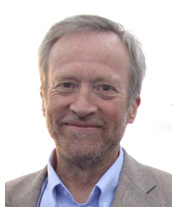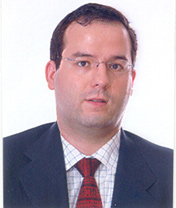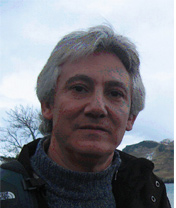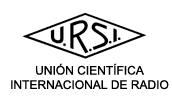URSI 2012 ELCHE
Conferencias Plenarias
OTA Characterization of Wireless Terminals in Rich Isotropic Multipath (RIMP) and pure-LOS
Professor Per-Simon Kildal, Chalmers University of Technology
The reverberation chamber has during the last 10 years been developed into a fast, accurate and cost-effective instrument for emulating rich isotropic multipath (RIMP) and thereby characterizing small antennas and wireless terminals Over-The-Air (OTA) during fading [1]. The RIMP environment is an extreme reference environment, in the same way as the pure-LOS (Line-of-Sight) environment emulated by an anechoic chamber is another extreme reference environment. The pure-LOS is classically used for evaluating directive antenna systems with fixed or steerable narrow beams. However, a wireless terminal does not have a directive antenna, and it is also strongly affected by the random characteristics of the user, such as his orientation and how he holds the terminal. Therefore, the pure-LOS will appear as a random LOS when considering the statistics of an ensemble of users, and the characterization of the LOS part must be done by maximizing the probability of detecting the transmitted bit stream(s) over the ensemble of users.
The presentation will explain how efficiency, antenna diversity gain and maximum available Shannon capacity [2] can be measured in the reverberation chamber, as well as total radiated power, receiver sensitivity and data rate throughput. The latter are characteristics of complete real smart wireless devices - and not only their antennas - including the system implementations of the antenna diversity (also called SIMO and MISO), MIMO multiplexing (i.e. receiving more than one bit stream) and OFDM (diversity in the frequency domain). The effect of the OFDM can be tested for different time delay spreads and coherence bandwidths, because these parameters can be easily controlled in the reverberation chamber within most practical limits, so that both frequency-selective and frequency-flat fading can be achieved. The measured throughput for an LTE device with MIMO and OFDM is in agreement with a simple system model based on treating the receiver on each antenna port as an ideal threshold receiver [3]. The throughput results show also a direct relation between previously defined diversity gains [4] and the quality of the throughput [1].
The simple threshold model makes it possible to refer to a relative throughput curve versus average power level as being the probability of detection of the bit stream(s), in the same way as group error rate curve (BLER or FER) represents outage probability (the outage probability is the complementary to the detection probability). This opens up for designing multi-port antennas that maximize the detection probability, including whatever statistical factors are of interest to include such as the randomness of the user. This is in agreement with good practices in communication systems theory seeking to minimize outage probability.
The presentation concludes by introducing a RIMP/pure-LOS hypothesis: If a wireless device can be shown to have good performance both in RIMP and pure-LOS environments, it will also have good performance in real-life environments, in terms of maximizing the probability of bit stream detection. It is a major research task to show under which conditions this is true, although many researchers with whom I have discussed it agrees that it intuitively seems valid, and not the least a constructive way forward for research on OTA testing of wireless devices.
References
[1] P.-S. Kildal, C. Orlenius, and J. Carlsson, "OTA Testing in Multipath of Antennas and Wireless Devices with MIMO and OFDM," Proceedings of the IEEE, vol. 100, pp. 2145-2157, July 2012.
[2] P. S. Kildal and K. Rosengren, "Correlation and capacity of MIMO systems and mutual coupling, radiation efficiency, and diversity gain of their antennas: simulations and measurements in a reverberation chamber," IEEE Communications Magazine, vol. 42, pp. 104-112, 2004.
[3] P. S. Kildal, A. Hussain, X. Chen, C. Orlenius, A. Skårbratt, J. Åsberg, T. Svensson, and T. Eriksson, "Threshold Receiver Model for Throughput of Wireless Devices with MIMO and Frequency Diversity Measured in Reverberation Chamber," IEEE Antennas and Propagation Wireless Letters, vol. 10, pp. 1201-1204, October 2011.
[4] K. Rosengren and P. S. Kildal, "Radiation efficiency, correlation, diversity gain and capacity of a six-monopole antenna array for a MIMO system: theory, simulation and measurement in reverberation chamber," Microwaves, Antennas and Propagation, IEE Proceedings -, vol. 152, pp. 7-16, 2005.
 Professor Per-Simon Kildal, Distinguished Lecturer of IEEE Antennas and Propagation Society
Professor Per-Simon Kildal, Distinguished Lecturer of IEEE Antennas and Propagation Society
Per-Simon Kildal is professor in antennas at Chalmers University of Technology in Gothenburg, Sweden since 1989. He is heading the Antenna group. His main tasks are to lead and supervise research and education within antenna systems. Until now, 18 graduate students have received a Ph.D. from him.
Kildal received two doctoral degrees from the Norwegian Institute of Technology in Trondheim. He is a Fellow of IEEE since 1995, and in 2011 he was awarded the prestigious Distinguished Achievements Award from the IEEE Antennas and Propagation Society.
Kildal has authored more than 120 articles in scientific journals; concerning antenna theory, analysis, design and measurements, two of which was awarded best paper awards by IEEE (1985 R.W.P. King Award and 1991 Schelkunoff Prize Paper Award). He is the inventor behind technologies such as the dipole with beam forming ring, the hat antenna (produced in more than 850 000 samples for microwave links), and the eleven feed. Kildal has done the electromagnetic design of the Gregorian dual-reflector feed for the 300 m diameter radio telescope in Arecibo on contracts for Cornell University.
Kildal was the first to introduce the reverberation chamber as an accurate measurement instrument tool for Over-The-Air (OTA) characterization of small antennas and wireless terminals for use in multipath environments with fading. Kildal is also the originator of the concept of soft and hard surfaces from 1988, today being characterized as the first metamaterials concept. This concept is the basis of his newest and most fundamental invention, the gap waveguide technology.
Kildal’s research is innovative and industrially oriented, and has resulted in several patents and related spinoff companies, the most known being Bluetest AB, see www.kildal.se for more details.
Dr. Kildal is examiner and teacher of the undergraduate Antenna Engineering course at Chalmers based on his textbook Foundations of Antennas - A Unified Approach (Lund, Sweden: Studentlitteratur, 2000). He organizes and lectures in courses within the European School of Antenna (ESoA, www.antennasvce.org).
Crecimiento y Densificación de los Datos Móviles
José Valerdi Tormo, Orange
Debido al aumento de la penetración de los smartphones en España, y la aparición de nuevas tecnologías emergentes como LTE, los operadores de telecomunicaciones se enfrentan al reto de poder hacer frente de forma eficiente a la creciente demanda de datos móviles que se prevé se multiplique x1000 en los próximos años. Este problema se acentúa en determinadas áreas altamente pobladas o densas.
El uso de redes heterogéneas que combinan distintas tecnologías puede representar una solución eficiente para hacer frente a este reto, al tiempo que se intenta mantener el mismo nivel de experiencia de usuario extremo a extremo.
La conferencia plenaria abordará diferentes aspectos de las redes heterogéneas, en concreto como desplegar este tipo de redes, lo cual permitirá introducir distintas soluciones basadas en micro, pico celdas y small cells, un concepto nuevo que cada vez está más en auge en el mercado. La conferencia analizará también cuando es el mejor momento para desplegar redes heterogéneas, así como los mecanismos necesarios para que el usuario final no se vea impactado por un problema que es puramente tecnológico.
 José Valerdi Tormo, Orange
José Valerdi Tormo, Orange
Ingeniero de telecomunicaciones por la Universidad Politécnica de Valencia, se unió al grupo France Télécom en el año 2001. Inició su labor en el Departamento de Sistemas de Información donde fue responsable de la calidad de la información y la integración de los distintos sistemas de la compañía (acceso, billing, provisión, CRM). En 2004, recibió el premio al mejor proyecto de Integración de Sistemas de Información del grupo. Posteriormente se incorporó al Departamento de R&D donde ha sido Director, liderando la unidad internacional que el grupo France Télécom tiene en España hasta el 2011. En la actualidad, forma parte del equipo de proyecto del programa estratégico “Seamless Wireless Access” a nivel corporativo, como director del programa para España y director del stream “Best Coverage” para todo el grupo.
Fue Profesor Asociado (área de Teoría de la Señal y Comunicaciones) de la Universidad Miguel Hernandez de Elche desde 2001 a 2003. En 2006 obtuvo un EMBA por la Universidad Pontificia de Comillas. En la actualidad, es miembro del Advisory Board de la startup VLC-Photonics (spin-off de la Universidad Politécnica de Valencia) dedicada al diseño e implementación de circuitos ópticos de alta densidad.
Transmisión Extraordinaria vista por un Ingeniero de Microondas
Francisco Medina Mena, Universidad de Sevilla
Desde el descubrimiento de la denominada “transmisión óptica extraordinaria” (EOT por sus siglas en inglés) se ha publicado una ingente cantidad de artículos que analizan todos los aspectos de este, inicialmente, enigmático fenómeno. El paradigma dominante que explica este fenómeno se fundamenta en la interacción entre ondas planas y ondas de superficie soportadas por estructuras periódicas. Aunque esta perspectiva es correcta, existe una formulación alternativa (y compatible) del problema basada en la práctica habitual de los ingenieros de microondas, en la que se buscan modelos de circuito analíticos que capturen lo esencial de la física del problema. En la charla se efectuará una revisión de las aportaciones propias y ajenas que ilustran lo fructífero de esta forma de proceder.
 Francisco Medina Mena, Universidad de Sevilla
Francisco Medina Mena, Universidad de Sevilla
Francisco Medina ha sido Profesor Titular de Electromagnetismo en el Dpto. de Electrónica y Electromagnetismo de la Facultad de Física de la Universidad de Sevilla desde 1989, y Catedrático desde 2009. En la actualidad es responsable del Grupo de Microondas de la Universidad de Sevilla. Su investigación se ha desarrollado principalmente en el campo del Electromagnetismo aplicado a problemas de guiado, radiación y scattering ligados al modelado de circuitos y antenas impresos de RF y microondas. Sobre estos temas ha publicado extensamente en revistas de antenas, ingeniería de microondas y física, así como en congresos nacionales e internacionales de esos campos. Por sus contribuciones en el campo de la ingeniería de microondas fue nombrado Fellow del IEEE en el año 2010.















